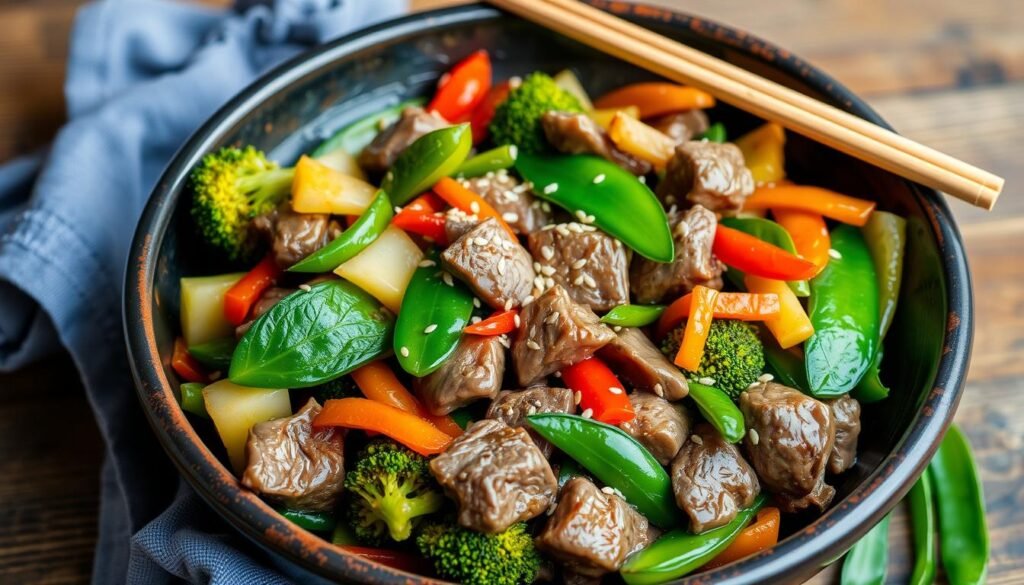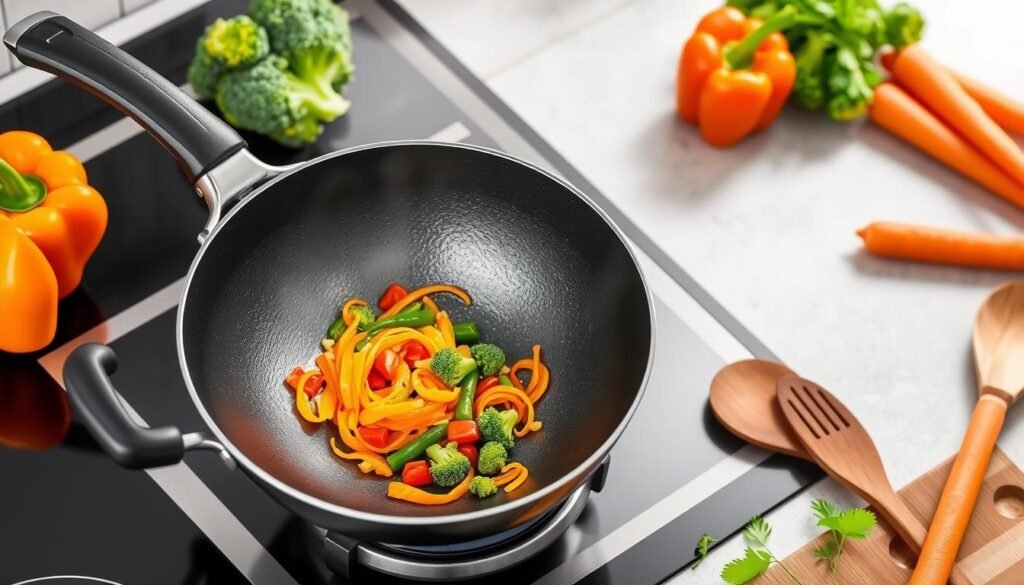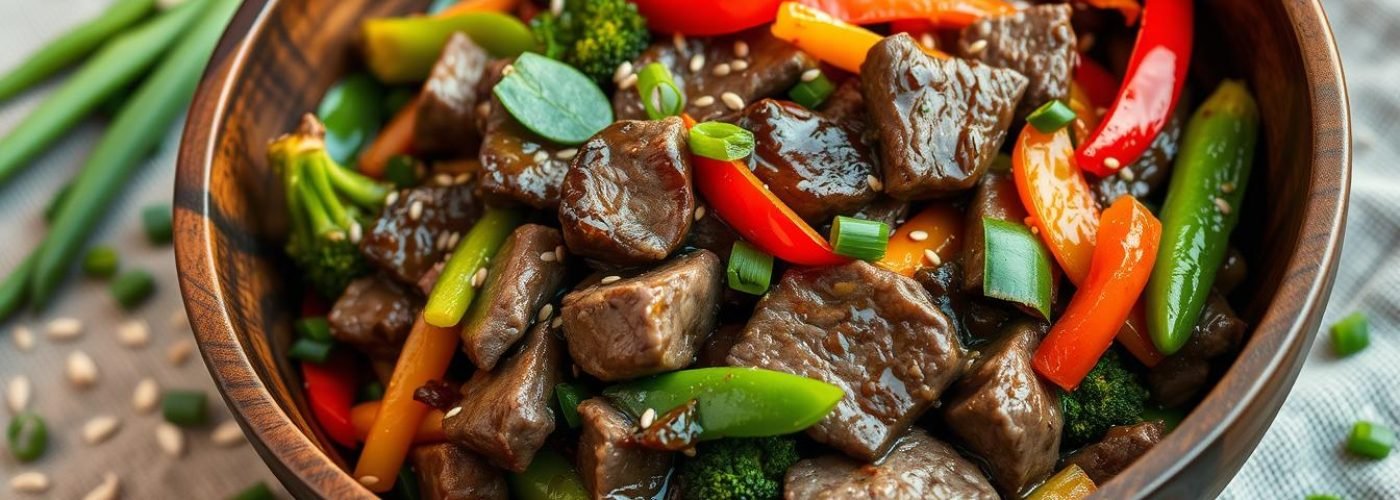Are you looking for a delicious and nutritious way to spice up your weeknight meals? A Balanced Beef & Veggie Stir-Fry brings together tender beef and a colorful selection of vegetables, making it a perfect Healthy Dinner Recipe. This Quick Stir-Fry Meal not only satisfies your taste buds but also supports your commitment to a balanced diet. With simple ingredients and straightforward cooking methods, this dish caters to all cooking skill levels, ensuring everyone can enjoy a tasty and wholesome dinner.
Why Choose a Stir-Fry for Dinner
Stir-frying stands out as a go-to option for families seeking quick dinner recipes. When life gets busy, stir-fry offers speed without sacrificing nutrition or flavor. A typical stir-fry can be ready in under 30 minutes, making it an essential choice for weeknight meal ideas. The high heat of the cooking surface locks in moisture, flavor, and nutrients, providing a wholesome dining experience.
Quick Cooking for Busy Nights
The fantastic aspect of stir-frying is its efficiency. By using a wok or a large pan, ingredients cook rapidly. This method ensures that vegetables remain crisp and flavorful while proteins retain their succulence. Parents appreciate how easily stir-frying fits into tight schedules. Minimal preparation means less time in the kitchen, allowing more moments with loved ones.
Health Benefits of Stir-Fry Meals
Incorporating a variety of vegetables and lean proteins yields multiple health benefits of stir-fry. This cooking method promotes a diet rich in essential vitamins and minerals. Opting for minimal oil ensures that the meals stay light yet satisfying, which aids in cooking healthily. Research highlights the importance of colorful produce, as it can reduce the risk of chronic diseases. This makes stir-frys not just delicious but also a vital part of a nutritious lifestyle.
Ingredients for Balanced Beef & Veggie Stir-Fry
Creating a delicious and nutritious stir-fry relies heavily on selecting the right ingredients. This section focuses on choosing the best beef cuts for stir-fry and the essential vegetables that enhance flavor and nutrition.
Choosing the Right Cut of Beef
For a balanced beef and veggie stir-fry, opting for lean beef options is essential. Cuts such as sirloin, flank steak, and top round are among the best beef cuts for stir-fry. These cuts provide a great combination of flavor and tenderness while being lower in fat, resulting in a healthier meal. When making your beef selection, look for bright red color and minimal marbling, which indicate freshness and quality.
Essential Vegetables to Include
A vibrant stir-fry is incomplete without an array of stir-fry vegetables. Essential veggies like bell peppers, broccoli, snap peas, and carrots contribute both color and essential nutrients to your dish. Incorporating mushrooms and onions enhances the umami flavor of the meal, while leafy greens like bok choy add volume and fiber. Always consider using in-season produce to ensure the best flavor and nutrition, making your vegetable selection even more impactful.
| Beef Cut | Fat Content | Flavor Profile |
|---|---|---|
| Sirloin | Lean | Rich, beefy flavor |
| Flank Steak | Lean | Bold, hearty taste |
| Top Round | Very lean | Mild, versatile flavor |
| Bok Choy | N/A | Sweet, mild flavor |
| Broccoli | N/A | Earthy, slightly bitter |
| Bell Peppers | N/A | Sweet, crisp taste |
Step-by-Step Cooking Instructions
Achieving a delicious stir-fry requires precise stir-fry preparation and an understanding of effective cooking techniques. This section delves into essential steps that elevate your dish, beginning with proper ingredient handling.
Preparing the Ingredients
Start by washing all vegetables thoroughly. Utilize consistent ingredient cutting techniques to ensure even cooking. Slice vegetables into uniform pieces, allowing them to cook evenly. For the beef, cut it against the grain into thin strips, around ¼ inch thick, to promote tenderness. Prepping for stir-fry also includes creating a flavorful marinade. Combine low-sodium soy sauce, minced garlic, and fresh ginger in a bowl. Allow the beef to marinate for a minimum of 15 minutes to deepen the flavor profile.
Cooking Techniques for Optimal Flavor
Select a large wok or skillet and heat it over high heat. Introducing a small amount of oil—sesame or avocado works well—will help prevent sticking. Once the oil is hot, add the marinated beef in a single layer. Cook until browned, typically around 2-3 minutes, and then remove it from the pan. In the same vessel, add your vegetables, starting with those that need more time, such as carrots and bell peppers. Utilize stir-frying techniques by tossing the ingredients frequently to achieve the perfect tenderness without losing crunch. After several minutes, return the beef to the mix, cooking for an additional 2-3 minutes until everything is hot and maintains its vibrant color. For a finishing touch, drizzle a splash of soy sauce to enhance the overall flavor.
Balanced Beef & Veggie Stir-Fry Recipe Overview
The balanced beef and vegetable stir-fry offers a vibrant combination of nutrients while being an easy stir-fry recipe to prepare. This dish features protein-rich beef paired with an array of colorful vegetables, creating a visually appealing and delicious meal. The cooking overview includes steps that emphasize quick preparation and minimal cleanup, making it a fantastic choice for weeknight dinners.
Consider incorporating a variety of vegetables such as bell peppers, broccoli, and snap peas to enhance both flavor and texture. The flexibility of this easy stir-fry recipe allows for personalization, catering to a range of dietary preferences. Whether someone desires extra spice or prefers a milder taste, this beef and vegetable stir-fry meets various palates.
Utilizing a flavorful sauce brings the dish together, delivering savory notes that enhance the overall experience. The methodology of this cooking overview ensures that every ingredient shines, contributing to a nutritious and satisfying meal. The balanced beef and vegetable stir-fry can easily become a staple in your dinner rotation, cherished for its simplicity and wholesome ingredients.

The Nutritional Benefits of This Recipe
A balanced beef and veggie stir-fry delivers numerous nutritional advantages, making it an excellent addition to your weekly meal prep. Understanding the macronutrient breakdown plays a crucial role in maintaining a healthy lifestyle. This dish prominently features lean protein, healthy fats, and a variety of vegetables, aligning well with dietary guidelines aimed at promoting healthy eating and balanced meals.
Understanding Macronutrients
Each serving of this stir-fry provides a satisfying mix of macronutrients. The protein in stir-fry, primarily coming from the beef, aids in muscle repair and growth. The colorful vegetables contribute essential vitamins and minerals while offering a low-calorie source of carbohydrates. Utilizing a small amount of healthy fats, such as olive or sesame oil, enhances the dish’s flavor without compromising its nutritious profile.
How It Fits into a Healthy Diet
Incorporating this stir-fry into your meal plan supports your efforts to achieve a balanced diet. Nutrient-dense vegetables pack a punch of antioxidants and fibers, helping maintain energy levels and promote overall health. By prioritizing high-quality, whole food ingredients, this recipe encourages adherence to healthy eating principles while allowing for customization to meet various dietary preferences.
| Component | Benefits |
|---|---|
| Protein in Stir-Fry | Supports muscle growth and recovery. |
| Healthy Fats | Provides essential fatty acids and supports cognitive function. |
| Vegetables | Offers vitamins, minerals, and antioxidants for overall health. |
| Carbohydrates | Sources of energy for daily activities. |
Flavor Enhancements for Your Stir-Fry
To truly elevate your stir-fry, exploring creative stir-fry marinades and seasoning ideas is essential. Experimenting with flavors will not only make your meal more enjoyable but also provide a delightful variety to your family dinners. Beyond traditional soy sauce, consider using teriyaki sauce, oyster sauce, or crafting a homemade marinade featuring ginger, garlic, and a splash of citrus for a refreshing twist.
Marinades and Seasonings to Try
Incorporating fresh herbs, such as cilantro and green onions, can add a burst of brightness to your dish. Here are some stir-fry marinades and seasonings to enhance your meals:
- Teriyaki sauce for a sweet glaze
- Oyster sauce for umami depth
- Homemade mixture with ginger, garlic, and citrus
- Thai chili sauce for a spicy kick
Adding Spice Without Extra Calories
If you’re looking to add heat without extra calories, focus on healthy spice options. Incorporate low-calorie flavoring through ingredients like red pepper flakes, chili paste, or fresh sliced chilies. These options can bring your dish to life while maintaining its nutritional quality. Here’s a brief overview of flavorful spices to consider:
| Spice | Flavor Profile | Caloric Content (per teaspoon) |
|---|---|---|
| Red Pepper Flakes | Spicy and tangy | 6 calories |
| Chili Paste | Rich and spicy | 25 calories |
| Fresh Sliced Chilies | Fresh and fiery | 0 calories |
Customizing Your Stir-Fry
Stir-fry recipes offer remarkable versatility, making them perfect for accommodating dietary needs without sacrificing flavor. The process allows for an array of stir-fry substitutions that cater to various preferences. Whether a person follows a specific diet or simply wants to try something new, customization is key.
Substitutions for Dietary Preferences
For those looking to replace beef, consider options such as chicken, shrimp, or tofu. These proteins will maintain the dish’s essence while allowing for different flavors and textures. An inventive twist involves swapping vegetables based on what’s fresh or in season, encouraging culinary creativity and minimizing food waste.
Vegetarian or Vegan Alternatives
Incorporating a vegetarian option is straightforward. Tempeh or seitan can replace beef while adhering to the same cooking method, yielding scrumptious results. For a vegan stir-fry recipe, utilize plant-based alternatives and check that any sauces are devoid of animal products. This adaptability means that the balanced beef and veggie stir-fry can be enjoyed by everyone.
Cooking Tools and Utensils Needed
When it comes to stir-frying, having the right tools is essential for achieving delicious results. Utilizing the best wok for stir-frying not only enhances flavors but also ensures that cooking is efficient. A large wok features sloped sides, perfect for retaining high heat and allowing for even cooking. In the absence of a wok, a sturdy skillet can serve as a suitable alternative. Opt for cookware that has a non-stick surface or is well-seasoned to prevent food from sticking.
Choosing the Right Pan or Wok
Selecting the appropriate pan or wok is key to successful stir-frying. The following table highlights some features to consider when choosing your cooking vessel:
| Type | Best For | Material | Size |
|---|---|---|---|
| Wok | Stir-frying vegetables and meats | Carbon steel or non-stick | 14″-16″ |
| Skillet | General frying and sautéing | Stainless steel or non-stick | 12″-14″ |
| Cast Iron Wok | High-heat searing | Cast iron | 12″-16″ |
Essential Utensils for Stir-Frying
To maximize the effectiveness of your stir-frying, incorporating necessary cooking tools is vital. The following utensils will make the process easier:
- Spatula: Ideal for stirring and flipping ingredients.
- Wooden spoon: Gentle on non-stick surfaces while mixing.
- Tongs: Useful for maneuvering meat and vegetables.
- Sharp knife: Ensures ease in chopping and preparation.
- Cutting board: A stable surface for safe ingredient prep.

How to Serve Your Balanced Beef & Veggie Stir-Fry
Serving your balanced beef and veggie stir-fry allows for creativity, enhancing the meal’s overall enjoyment. Thoughtfully pairing the dish with toppings and sides can create a complete dining experience. Consider these insights for an appealing presentation and satisfying combinations.
Pairing with Rice or Noodles
Choosing the right base is essential. Consider these rice and noodle options:
- Brown rice for added fiber and nutrients
- Quinoa, a protein-rich alternative
- Whole-grain noodles for a heartier base
Serve the stir-fry generously over one of these options for a well-rounded meal. Adjust portion sizes based on dietary needs while ensuring a good balance of protein and carbohydrates. These serving suggestions will cater to different tastes and nutritional goals.
Garnishing Ideas for Presentation
The visual presentation of your stir-fry plays a big role in its appeal. Consider these presentation tips for garnishing your stir-fry:
- Sprinkle chopped green onions for a pop of color
- Add sesame seeds for a nutty flavor
- Top with fresh cilantro to elevate the dish
- A squeeze of lime or lemon juice enhances freshness
These touches not only make the dish more enticing but enhance the flavor profile beautifully.
Storing Leftovers Safely
Storing leftovers from your beef and veggie stir-fry properly can enhance your meal enjoyment later on. Employ ideal food storage techniques to ensure your dish remains delightful. Start by selecting airtight containers to lock in freshness. Allow your stir-fry to cool at room temperature before refrigerating. This step reduces condensation, minimizing the risk of sogginess in your leftovers. If stored correctly, your stir-fry can stay fresh in the refrigerator for up to three days.
Storage Tips for Maximum Freshness
- Use airtight containers to keep air out and moisture in.
- Label containers with the date to track freshness.
- Divide large portions into smaller servings for easier reheating.
- Store at the back of the refrigerator where temperature is most stable.
Reheating Instructions
When it’s time to enjoy your leftovers, follow these reheating tips. For warming up stir-fry, a skillet over medium heat is recommended. This method retains texture while allowing even warming. Adding a splash of water or broth aids in preventing dryness. While the microwave might seem convenient, it often leads to uneven oxidation and can compromise taste. Ensure your stir-fry is heated thoroughly to guarantee food safety before serving.
Common Mistakes to Avoid When Stir-Frying
Stir-frying is a popular cooking method that can lead to delicious meals when executed correctly. Despite its straightforward process, there are some common stir-frying errors that home cooks frequently encounter. Awareness of these cooking mistakes to avoid can elevate the quality of your stir-fry significantly. Understanding proper stir-frying techniques is essential for achieving the best results.
Overcooking Your Ingredients
One major cooking mistake to avoid is overcooking your ingredients. Overcooking can result in a loss of nutrients and create an undesirable texture, especially with vegetables that should retain some crunch. Proper stir-frying techniques dictate that you should add ingredients in the right order. Start with proteins, followed by hearty vegetables, and finish with softer items. This method ensures that each component cooks adequately while retaining its individual characteristics.
Neglecting the Stir-Fry Technique
Another common error involves neglecting the essential stir-fry technique. Constant movement in the pan is necessary to promote even cooking and prevent burning. High heat is crucial for achieving that signature flavor and texture, and continuously stirring keeps everything from sticking or cooking unevenly. Effective cooking tips emphasize that understanding the timing for each ingredient will help achieve the perfectly cooked stir-fry you desire.
Where to Find the Best Ingredients
When preparing your Balanced Beef & Veggie Stir-Fry, sourcing the right ingredients is crucial for maximizing flavor and nutrition. Local grocery store tips include checking the freshness of produce and the quality of meat sections. Always opt for vibrant vegetables and well-marbled cuts of beef to ensure you’re starting with the best foundation for your meal.
Farmers’ markets are a fantastic option for fresh ingredient sourcing. Here, you can often find seasonal vegetables and high-quality meats directly from local producers. This not only supports your community but also guarantees that you’re using ingredients at their peak freshness, enhancing the overall taste of your stir-fry.
Additionally, don’t forget to explore specialty sections in your local grocery stores for international ingredients that can help you achieve an authentic flavor profile. Keep an eye out for sales or promotions on fresh ingredients; this allows you to enjoy excellent quality without breaking the bank. With a little effort in sourcing, your stir-fry will not only be delicious but also nourishing.

